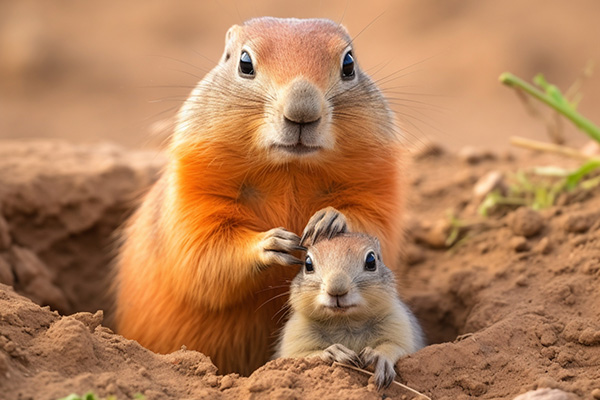The Endangered Spiritual Wisdom Of The Prairie Dog
 In Native American wisdom tradition, when a prairie dog crosses our path, it brings a sacred message of retreat. During times of stress and overexertion, this wise little creature reminds us to pause and step back from the chaos of modern life to recharge.
In Native American wisdom tradition, when a prairie dog crosses our path, it brings a sacred message of retreat. During times of stress and overexertion, this wise little creature reminds us to pause and step back from the chaos of modern life to recharge.
Prairie dogs often appear when we find ourselves in situations we’d rather avoid, encouraging us to disengage and reset. It teaches us to choose our battles carefully and not expend energy where it isn’t needed.
If you’ve been feeling overwhelmed, emotionally drained, or spiritually disconnected, the prairie dog may be offering you a compassionate wake-up call.
Like this gentle guardian of the grasslands, you are invited to retreat to your own sacred space of stillness and safety, where you can restore your strength and clarity.
In nature, when the prairie dog senses danger, it instinctively retreats into its burrow, which is equipped with multiple escape routes. It doesn’t flee in panic, but rather responds with grounded wisdom and preparation.
In this way, prairie dog medicine teaches us how vital it is to create our own safe haven in life. We all need a place of inner peace, ritual, and refuge.
Paradoxically, the prairie dog also symbolizes the importance of reconnecting. If we become too withdrawn from our loved ones or isolated from community and nature, this magical creature encourages us to reach outward toward laughter, kinship, and shared purpose. It reminds us that solitude and social connection are not opposites, but rather part of a sacred rhythm.
Prairie Dog calls me when it’s time to rest, when it’s time to honor the internal quest. I go into retreat so I may see, a way to replenish the potential in me ~ Jamie Sams & David Carson
Sadly, prairie dogs are not only undervalued for their spiritual symbolism in today’s world, they are now also in grave ecological danger. Wildlife statistics reveal a staggering decline in prairie dog populations, with an estimated loss of 87% to 99% across their historic range. Once thriving across the vast plains of North America, prairie dogs now inhabit as little as 1% of their original territory.
This dramatic reduction is fueled by habitat destruction, widespread poisoning, recreational shooting contests, trapping, invasive diseases, and relentless urban development. While precise annual death tolls are difficult to quantify, the cumulative effect of these threats results in the loss of tens of thousands of prairie dogs each year.
Their rapid decline underscores the urgent need for compassionate conservation efforts and greater public awareness.
By honoring the prairie dog as both a keystone species and a spiritual messenger, we can transform our relationship with the natural world from one of domination to one of reverence. Let this humble creature guide you when you need rest or reconnection and remind you that both are sacred acts of healing.
My grandmother grew up in New Mexico and used to tell me stories about prairie dogs and her love for them. I understand why she loved them so much, and I’m glad I live in a community that protects these precious native animals.
In Santa Fe, where I live, many of their colonies were historically located in the busiest part of town. You could see them while sitting in your car at major intersections where cars and the commuter train to Albuquerque crossed. It was lovely to watch them while waiting for the light to change or the crossing arm to go up.
Nine different wildlife species depend on the prairie dog and their habitat for their survival. The prairie dog is a critical component to healthy North American grasslands ~ Dr. Jane Goodall
Fortunately, Santa Fe is very “critter-friendly” and went to great lengths to relocate the prairie dogs properly. In 2001, the city passed an ordinance requiring the humane relocation of prairie dogs from development sites before lethal control measures could be employed.
The prairie dogs are humanely trapped as they exit their burrows and relocated to a holding facility or a new burrow with a holding cap for slow release. During the transfer, the prairie dogs receive health and wellness checks, as well as any necessary veterinary care. They are also fed ample amounts of food. Prairie dogs are kept with their families. Colonies number 1,000 prairie dogs at most, and they are moved in batches over a few months.
The new burrows are located in protected areas where the prairie dogs will not be hunted or poisoned. The burrows are either pre-existing and restored or new burrows created with nest boxes and drainpipes about four feet underground.
After the prairie dogs are released, a temporary holding cage in the form of a rabbit hutch is placed over the burrow. The hutch remains over the burrow for three to five days, allowing the prairie dogs to safely acclimate to their new home. The hutches are stocked with moist food and shaded to protect against predators. Once the hutch is removed, the prairie dogs are free to run around their new habitat, dig to their heart’s content, and enjoy their safe new homes.
These efforts demonstrate a commitment to coexistence and ecological stewardship. Santa Fe’s approach is often cited as a model by other communities that are struggling with urban wildlife management.
Although I miss watching the prairie dogs in their former habitats, I’m grateful they are now in safer, more appropriate ones. From their new home, they will continue to remind us of the importance of community and the value of retreating into spiritual solitude and inner silence. It is there that we can find renewed strength and wisdom.
|
|
This site uses Akismet to reduce spam. Learn how your comment data is processed.
- Joan on Reflections On Time…And The Timeless
- Ma8 on Reflections On Time…And The Timeless
- Flowers name in Hindi on The Mystical Secrets Of Flowers
- Pam on How To Connect With Your Guardian Angel
- astrosaiganesh on How To Navigate The Sun’s Debilitation In Libra
- mahendar on What Happens To Our Pets When They Cross Over
- Megan Gutleben on How To Maintain A High Vibe Every Day
- spiritual healing on The True Role Of The Spiritual Healer
- Mballe on Why Some Souls Depart This Life Early
- Elizabeth Ocskay on The Mystery Of Soul Groups And Soul Contracts
- Christopher Guleff on The Mystical Purpose Of Daydreaming
- devanand astrologer on Psychic Messages In Mediumship Readings
- Linda Deir on Our Pets Speak To Us In This Life And Beyond
- Veronica on Why Some Souls Depart This Life Early
- astrologer devanand on Chakra Balancing Is An Essential Self-Care Practice
- Kirti on How To Deal With Negativity And Toxic Drama
- psychicramdev on How To Navigate The Sun’s Debilitation In Libra
- Grace on The Psychic Technique Of Remote Viewing
- Pam on Energy Protection 101
- Jo on The Principles Of Ethical Psychic Reading

Leave a Reply